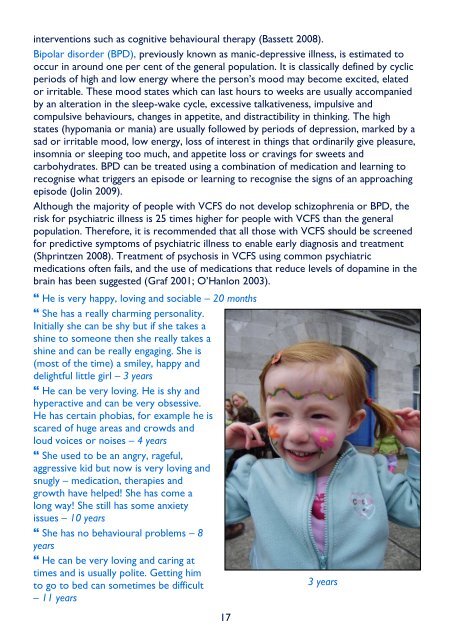22q11.2 deletions syndrome (Velo-Cardio-Facial Syndrome) FTNW
22q11.2 deletions syndrome (Velo-Cardio-Facial Syndrome) FTNW
22q11.2 deletions syndrome (Velo-Cardio-Facial Syndrome) FTNW
- No tags were found...
You also want an ePaper? Increase the reach of your titles
YUMPU automatically turns print PDFs into web optimized ePapers that Google loves.
interventions such as cognitive behavioural therapy (Bassett 2008).<br />
Bipolar disorder (BPD), previously known as manic-depressive illness, is estimated to<br />
occur in around one per cent of the general population. It is classically defined by cyclic<br />
periods of high and low energy where the person‟s mood may become excited, elated<br />
or irritable. These mood states which can last hours to weeks are usually accompanied<br />
by an alteration in the sleep-wake cycle, excessive talkativeness, impulsive and<br />
compulsive behaviours, changes in appetite, and distractibility in thinking. The high<br />
states (hypomania or mania) are usually followed by periods of depression, marked by a<br />
sad or irritable mood, low energy, loss of interest in things that ordinarily give pleasure,<br />
insomnia or sleeping too much, and appetite loss or cravings for sweets and<br />
carbohydrates. BPD can be treated using a combination of medication and learning to<br />
recognise what triggers an episode or learning to recognise the signs of an approaching<br />
episode (Jolin 2009).<br />
Although the majority of people with VCFS do not develop schizophrenia or BPD, the<br />
risk for psychiatric illness is 25 times higher for people with VCFS than the general<br />
population. Therefore, it is recommended that all those with VCFS should be screened<br />
for predictive symptoms of psychiatric illness to enable early diagnosis and treatment<br />
(Shprintzen 2008). Treatment of psychosis in VCFS using common psychiatric<br />
medications often fails, and the use of medications that reduce levels of dopamine in the<br />
brain has been suggested (Graf 2001; O‟Hanlon 2003).<br />
He is very happy, loving and sociable – 20 months<br />
She has a really charming personality.<br />
Initially she can be shy but if she takes a<br />
shine to someone then she really takes a<br />
shine and can be really engaging. She is<br />
(most of the time) a smiley, happy and<br />
delightful little girl – 3 years<br />
He can be very loving. He is shy and<br />
hyperactive and can be very obsessive.<br />
He has certain phobias, for example he is<br />
scared of huge areas and crowds and<br />
loud voices or noises – 4 years<br />
She used to be an angry, rageful,<br />
aggressive kid but now is very loving and<br />
snugly – medication, therapies and<br />
growth have helped! She has come a<br />
long way! She still has some anxiety<br />
issues – 10 years<br />
She has no behavioural problems – 8<br />
years<br />
He can be very loving and caring at<br />
times and is usually polite. Getting him<br />
to go to bed can sometimes be difficult<br />
– 11 years<br />
17<br />
3 years


